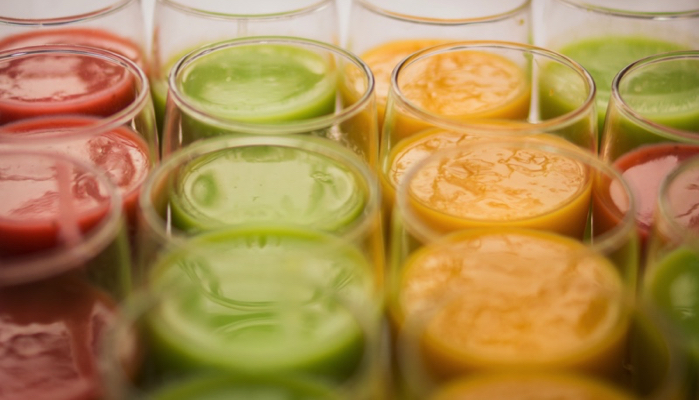Thickened Liquids: What is it, Who Needs it and Will Insurance Pay for it?

This post may contain affiliate links; please see our terms of use for details.
Why would someone want to thicken their liquids? If your child has problems swallowing, or dysphagia, it can be difficult for them to get thin liquids down the right side of their throat when drinking. Food and liquids should go down the esophagus to the the stomach, but can sometimes slip into the trachea and go to the lungs. This is called aspiration and can lead to coughing, choking or even (over time) pneumonia. Thickened liquids move a bit slower, giving the mouth and throat more time to respond and prepare.

Your doctor or Speech Therapist may order a Modified Barium Swallow Study (MBS) so they can see where foods and liquids go when your child swallows. The study is painless, although it can be hard to keep some people in the same position for the entirety of the test. They will have your child swallow different thicknesses of liquids to see which ones they can handle and may ask that you only give them nectar-thick, honey-thick or spoon-thick liquids (more on that below).
One question you may have is can you maintain hydration when drinking thickened liquids? The answer is yes! There have been multiple studies on the subject, but I can also say from experience that my son has been on honey-thick liquids for years now and he is definitely hydrated throughout the day. If you are concerned about your child’s hydration, keep an eye on the color of their urine (it should be a very light straw color) and note how often they urinate throughout the day. If you notice a decrease in urine output, you can talk to a nephrologist and try to increase their liquid intake.
Types of Thickened Liquids
Generally, doctors refer to four levels of liquid thickness. After testing through a swallow study, your child may be assigned a certain consistency of liquids.
Thin liquids: Most common thin liquids are water, milk, juice, coffee, tea or soda. Keep in mind that some foods may melt in your mouth to become thin liquids, like gelatin, ice cream or sorbet. Thin liquids can also hide in other foods, like soups or cereal with milk.
Nectar-thick liquids: Think of this thickness in terms of fruit nectars (like guava nectar, not guava juice), maple syrup, egg nog or tomato juice.
Honey-thick liquids: This one is easy. Liquids need to be the thickness of honey.
Spoon-thick liquids: For spoon-thick liquids you would want something that would stay on a spoon when turned to the side, like pudding.
Products to Thicken Liquids and Where to Get Them
There are many over-the-counter products designed to thicken liquids. You can buy these in powder form or as pre-mixed drinks and most are also available in bulk on Amazon. We’ve tried quite a few of them and by far our favorite is Nestle Resource ThickenUp Clear.
Each product will come with a chart letting you know how many teaspoons of powder you need to add to how many ounces of water in order to create nectar-, honey- or spoon-thick liquids.
- Nestle Resource ThickenUp Clear: This is our favorite thickener. It’s clear and flavorless and really does thicken up liquids well. You don’t need very much to get to the desired thickness. It is xantham-gum based with other ingredients.
- Resource Thickenup: Yes, it has a similar name, but no it’s not the same as Nestle Resource ThickenUp Clear. For one thing, this is a corn-starch-based product, not xantham gum. Also, you need to use a lot more scoops of powder to get to the desired thickness.
- SimplyThick: This is primarily xantham gum and can be a little lumpy. There was a very public series of infant deaths linked to SimplyThick a few years ago, but it is safe for older children and adults.
- Thick & Easy: We’ve not used Thick & Easy, but it is also a corn-starch-based product. Thick & Easy Clear is based on xanthum gum.
- Thick-It: Thick-It is another corn starch product. We’ve had the same problem with this one as Resource Thickenup in that it takes a lot of powder to get to honey-thick consistency.
Getting Thickeners Through Insurance
Even though these are all available for purchase without a prescription, talk to your doctor about getting your preferred thickener prescribed and provided through a medical supply company. Most insurance companies will cover thickener products, but there will be limitations. For example, they will most likely only use one or two approved medical supply companies and those companies will generally only offer one or two products to choose from.
I’d recommend trialling a few different products (buy small containers on Amazon) to see which ones work best for your family. We’ve definitely discovered that some thickeners are just not tolerated by our son’s discerning palate. In other words, he just refuses to drink them, so that’s not helping anyone!
Before going through the process of trying to get something approved through insurance, make sure they offer a product your child will actually use. It’s fairly easy to call your insurance company to find out which suppliers they use and which products they can offer you. In some cases, you can also look into a reimbursement program through your insurance where you purchase your preferred product and your insurance reimburses you later.
Other Food Options
Not everyone likes to use thickening products to make thickened liquids, although there are some advantages to using a product: it’s easy to teach others how to use it, where to get it and the results are usually really consistent. So if you are going to have to have multiple people in different locations creating thickened liquids, using a purchasable powder product or a pre-made drink is probably easiest.
But for some people, the thickeners may not have a nice taste or texture (and yes, even the tasteless ones can have a taste for some of us who are rather fastidious) or we may want to add more calories to our drinks for those on high-calorie diets.
In that case, there are ways to mix foods into your drinks to make them thicker. Keep in mind that these mix ins are far less exact than the powders, so you’ll have to work on making sure your measurements don’t change every time you make up a batch. Some options that we’ve tried:
- Mix baby oatmeal or rice cereal into milk, water or juice
- Mix pudding into milk or water
- Mash a banana and mix into milk or water
- Mix applesauce into water
- Mix other pureed fruits (like baby foods) into water
- Mix instant potato flakes into water
- Mix gelatin powder into water or juice
- Mix pudding mix into milk
Other Tips
- Want ice in your drink? Be careful! Ice melts and changes the thickness of your drink. Xanthan gum thickening products can be used to make ice cubes or popsicles, however thickening products that use corn starch will separate when melting.
- Once you get into the routine of making thickened liquids you also learn fast that it’s best to take your thickened liquids with you when going out rather than trying to make them while out and about. We make enough liquid for one day then bring our drink with us in a thermos. We like the YETI Rambler because it keeps liquids cold for up to 12 hours.
- Getting your fluids to the right thickness is just the first battle. Next you’ll need to find a good cup! We absolutely love the Mr Juice Bear drinking system. It’s easy to use and you can also squeeze the bear to push liquid through the straw and encourage more drinking. We’ve also heard good things about Nosey Cups and the Reflo Smart Cup.

The information WonderBaby provides is not intended to be, and does not constitute, medical or other health advice or diagnosis and should not be used as such. Always consult with a qualified medical professional about your specific circumstances.
Related Posts

Eye Conditions and Syndromes, Visual Impairment
Neuralink Announces Plans to Restore Sight to the Blind with Brain Chip
Elon Musk’s company Neuralink has announced plans to begin human trials of its new “Blindsight” brain chip by the end of 2025.

Health & Nutrition
Can Baby Skin Care Products Expire?
Is that forgotten tube of diaper rash cream still safe to use? Learn more about the expiration dates of popular skin care products for infants.

Health & Nutrition
Boosting Immunity in Kids: 3 Tips for a Healthy Winter
Parents can help boost their kids’ immunity during cold and flu season by maintaining healthy eating, sleeping, and exercising habits in the winter.